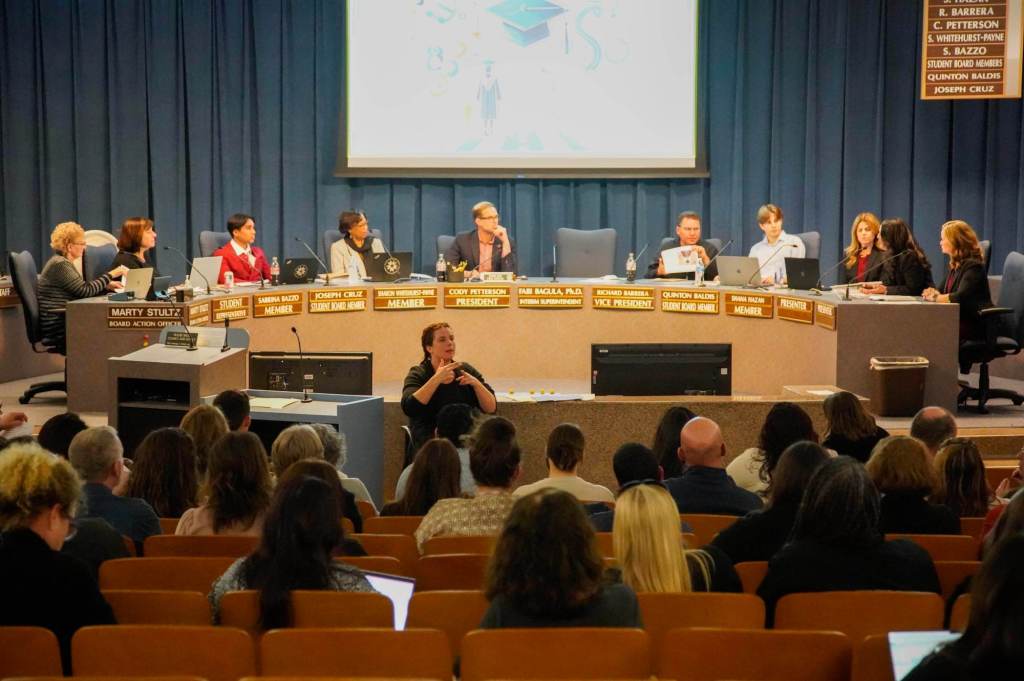
As it considers its options to close a gaping projected budget deficit of more than $100 million, San Diego Unified School District plans to departments and cut vacant jobs but also expects fewer layoffs than last year.
Much still remains up in the air, particularly on future funding from the state and federal governments, district officials acknowledged at a Tuesday night workshop where staff briefed the board of trustees on their budget process.
Late last year, district officials said they had managed to shrink their projected deficit by around $60 million but were still looking at a gap of $113 million — a gap they planned to close by spending down tens of millions in reserves and by offering early retirement to employees to thin its payroll.
But even that projection assumed a 2.9% cost-of-living increase in state funding next year. The governor’s proposed budget out last month included only a 2.4% increase — meaning less state funding for schools, and more budget cuts for districts.
With figures shared Tuesday, district officials appeared to be bracing for an even lower adjustment in the state’s final fiscal-year budget.
They also assume a budget deficit ranging between $106 million and $89 million — though they cautioned that some numbers could be out of date. The ranges depended on factors like the discretionary block grant and funding for transitional kindergarten.
On Tuesday night, W. Drew Rowlands, the district’s deputy superintendent of operations, said that he hesitated to promise there would be no layoff notices by March 15 — the deadline to notify layoffs ahead of the next school year — “because there are a few things we just need to do to clean some things up.”
But he also said there would be nowhere near the level of cuts made last year. “We’re not going to be anywhere in that kind of neighborhood this time,” he said.
One reason, he suggested: Nearly 1,000 employees took advantage of an early-retirement incentive the district recently offered. The deadline to submit for it has passed, so the district knows who will be gone, he noted.
Last month, the district said in a news release that 965 employees had taken the Supplemental Early Retirement Plan — higher than its target of 755. The district said at the time that people taking the plan allowed them to retain more employees.
Rowlands told The San Diego Union-Tribune that if everyone who left were replaced, the district would still save money, since new teachers are paid less than retired ones — but it wouldn’t save enough.
San Diego Unified’s teachers union, which has been pushing for more staffing, particularly in special education, said it would oppose cuts and demand the district use all available resources to staff schools.
“We are prepared to push back on any talk of more cuts,” Kyle Weinberg, the president of the San Diego Education Association, wrote in an emailed statement Wednesday. “We already have empty jobs we can’t even fill, especially in special education. We need more staff, not less.”
The board will hear another interim budget update in March. A final budget will be delivered in June.

The planned cuts come as San Diego Unified tries to close a large budget deficit it has attributed to enrollment drops, rising costs and the end of federal pandemic funding.
Budget consultants and district officials also spoke Tuesday to other state and federal funding uncertainties.
Patti Herrera, an executive at the consulting firm School Services of California, noted that Gov. Gavin Newsom’s budget proposes to reduce a threshold that would let the district qualify for a higher rate of funding per pupil. That would come with new requirements, such has providing wider access to expanded learning opportunity programs.
“We have a new administration in Washington with different views on immigration, fiscal policy, trade, all of those types of things,” said John Gray, the president and CEO of School Services. The state budget, he added, is “a work in process — so we need to keep our eye on that between now and the May revise, when the governor comes out and revises his budget.”
District officials also brought up the threats the White House has made to schools’ federal funding with executive orders that purport to withhold federal funding unless certain conditions are met.
Sierra Cook, the district’s director of government relations, presented a slide showing that federal revenue amounted to around 7% of San Diego Unified’s total budget.
In general, Cook said it was too soon to say what the impacts might be of several of President Trump’s executive orders on education — including one, issued Wednesday but already expected Tuesday night, that aims to diminish the U.S. Department of Education.
She said the district’s federal advocacy priorities included protecting vulnerable students, including LGBTQ+ and immigrant students. The district wants to protect students but recognizes that unless they feel safe at school, attendance could fall, further impacting its budget.
“Really, a lot of the work in this area is tracking and being prepared to respond to new policies,” she said. “We need to know what’s happening, and we need to be prepared. But really our commitment to our priorities is unchanged.”





